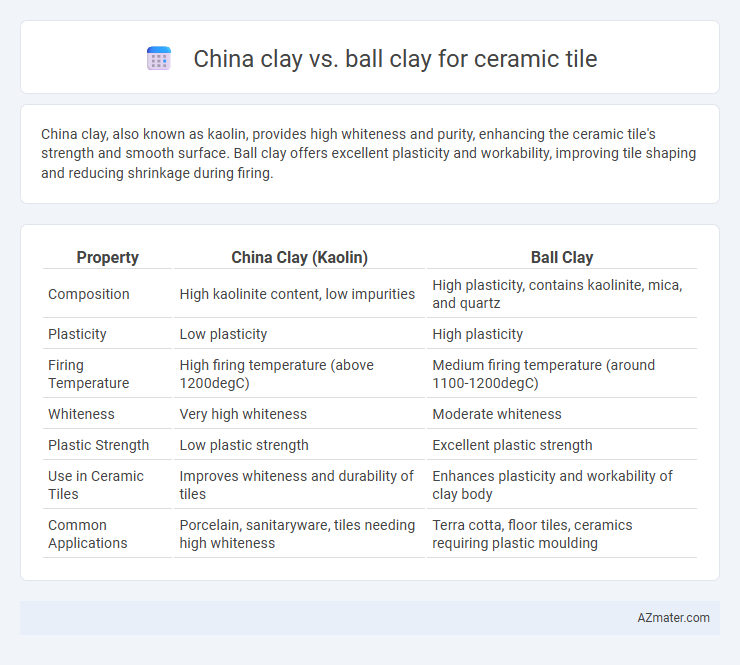China clay, also known as kaolin, provides high whiteness and purity, enhancing the ceramic tile's strength and smooth surface. Ball clay offers excellent plasticity and workability, improving tile shaping and reducing shrinkage during firing.
Table of Comparison
| Property | China Clay (Kaolin) | Ball Clay |
|---|---|---|
| Composition | High kaolinite content, low impurities | High plasticity, contains kaolinite, mica, and quartz |
| Plasticity | Low plasticity | High plasticity |
| Firing Temperature | High firing temperature (above 1200degC) | Medium firing temperature (around 1100-1200degC) |
| Whiteness | Very high whiteness | Moderate whiteness |
| Plastic Strength | Low plastic strength | Excellent plastic strength |
| Use in Ceramic Tiles | Improves whiteness and durability of tiles | Enhances plasticity and workability of clay body |
| Common Applications | Porcelain, sanitaryware, tiles needing high whiteness | Terra cotta, floor tiles, ceramics requiring plastic moulding |
Introduction to China Clay and Ball Clay
China clay, also known as kaolin, is a primary clay mineral valued for its high brightness, purity, and fine particle size, making it essential for ceramic tile production to improve whiteness and durability. Ball clay contains higher plasticity and fine particles, enhancing the green strength and workability of ceramic tiles during shaping and drying processes. Combining china clay and ball clay optimizes the balance between strength and plasticity, resulting in ceramic tiles with superior surface finish and structural integrity.
Geological Origins and Composition Differences
China clay, primarily kaolinite, originates from the chemical weathering of feldspar-rich igneous rocks, forming white, pure deposits with low plasticity ideal for creating hard ceramic tiles. Ball clay consists of a mix of kaolinite, mica, and quartz, derived from sedimentary processes and often contains higher organic content, providing greater plasticity and workability for shaping tiles. These geological and compositional differences impact the texture, firing behavior, and final strength of ceramic tiles, with China clay offering brightness and hardness, while ball clay imparts plasticity and green strength.
Key Physical Properties Compared
China clay (kaolin) exhibits higher purity with low iron content and finer particle size compared to ball clay, resulting in better whiteness and less discoloration in ceramic tiles. Ball clay offers greater plasticity and workability due to its higher organic content and smaller particle size distribution, which enhances the forming process of ceramic tiles. Both clays contribute differently to the tile body: china clay improves strength and thermal stability, while ball clay enhances green strength and reduces drying shrinkage.
Plasticity and Workability in Tile Production
China clay, also known as kaolin, possesses lower plasticity compared to ball clay, resulting in reduced shrinkage and enhanced whiteness in ceramic tile production. Ball clay exhibits higher plasticity and excellent workability, providing superior plastic strength, which facilitates molding complex shapes and improving tile mechanical properties. Combining China clay and ball clay optimizes the balance between plasticity and whiteness, making the mixture ideal for high-quality ceramic tile manufacturing.
Impact on Tile Color and Appearance
China clay, also known as kaolin, imparts a bright white base that enhances the brightness and purity of ceramic tile colors, making it ideal for achieving clean, vibrant finishes. Ball clay contributes to tile plasticity and strength but contains higher iron content, which can cause slight pigmentation shifts toward off-white or beige tones, subtly affecting the overall hue. The combined use of China clay and ball clay allows precise control over tile color and appearance, balancing whiteness and texture for a refined surface quality.
Firing Behavior and Temperature Response
China clay, or kaolin, exhibits high firing temperatures typically between 1200degC and 1400degC, promoting excellent whiteness and strength in ceramic tiles due to its high alumina content. Ball clay contains more fluxing agents and organic matter, resulting in lower firing temperatures around 1100degC to 1250degC and improved plasticity but with increased shrinkage and potential for warping. The temperature response of china clay ensures vitrification at higher firing stages, whereas ball clay contributes to workability and green strength but requires careful temperature control to prevent defects.
Influence on Tile Strength and Durability
China clay, also known as kaolin, enhances ceramic tile strength by providing a highly pure and fine particle structure, which results in improved hardness and reduced porosity. Ball clay contributes to tile plasticity and workability due to its higher plasticity index, but its higher impurities and finer particle size can reduce overall tile durability under mechanical stress. Optimizing the blend of China clay and Ball clay in ceramic tile formulation balances strength and durability, with China clay primarily boosting rigidity and Ball clay enhancing shape retention during firing.
Cost Considerations and Availability
China clay typically costs less than ball clay, making it a more economical choice for ceramic tile production. Ball clay's higher plasticity and strength come with a higher price, which can impact overall manufacturing expenses. Availability of china clay is generally more stable due to larger deposits, while ball clay may face regional supply constraints affecting consistent sourcing.
Environmental Impact and Sustainability
China clay, also known as kaolin, generally has a lower environmental impact than ball clay due to its relatively moderate extraction process and less intensive washing requirements, which reduce water consumption and contamination. Ball clay often demands more extensive processing to remove impurities, leading to higher energy usage and increased wastewater generation, posing greater environmental concerns. Sustainable ceramic tile manufacturing increasingly favors china clay for its cleaner extraction and processing, helping reduce the overall carbon footprint and water usage in production.
Choosing the Right Clay for Ceramic Tile Manufacturing
China clay, also known as kaolin, features high purity and low plasticity, making it ideal for white, translucent ceramic tiles with excellent strength and durability. Ball clay offers higher plasticity and better workability due to its fine particle size, which improves shape retention and flexibility during tile forming. Selecting the right clay for ceramic tile manufacturing depends on balancing whiteness, strength, plasticity, and firing temperature to achieve optimal tile quality and performance.

Infographic: China clay vs Ball clay for Ceramic tile
 azmater.com
azmater.com